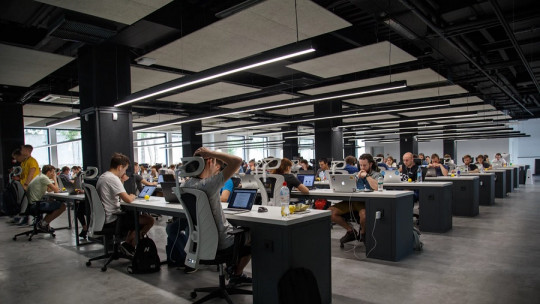The business world is complex, especially when we are dealing with an organization that has a large number of members.
One of the most relevant aspects to take into account is the selection and management of personnel, in which both the needs of the company and those of potential employees must be taken into account, trying to cover and maintain both coverage. Phenomena such as staff turnover which we are going to discover throughout this article.
What is staff turnover?
The process by which a company changes or replaces its employees is known as personnel rotation, generating exit or entry movements of one or multiple employees not due to natural processes such as retirement. It is generally linked to dismissal or resignation processes by employees, although sometimes may include the change of functions and position without the employee in question ceasing their relationship with the organization
Personnel rotation is a process that can have very different effects on both the company and the employee, whether the incoming or outgoing employee. In general, and especially when there is a high level of turnover, it has negative connotations, but occasionally it can be beneficial for one or all parties.
On the one hand, the entry and exit of employees allows the incorporation of new talents, ideas and points of view that can benefit the company as well as improving the working conditions of the outgoing employee or for him to acquire new experience in another position or company.
It also allows unproductive employees or those who do not fit the position they occupy to be replaced, or complex or excessively demanding positions to be revalued or their functions and workload modified. In addition, it allows the company to be rejuvenated.
For the other, can be a highly destructuring element for already formed work teams , may imply job destruction and economic and social difficulties for the outgoing employee or give society a negative image of the company (do they abandon it because their working conditions are disastrous?) and/or of the outgoing employee (is he or she not qualified for the position?). It also implies investment in training and the need for an adaptation period for those who occupy the positions.
Different types of rotation
Personnel turnover involves the separation, replacement or exchange of employees , but it does not always occur in the same way and for the same causes. In this sense, we can find various types of personnel rotation, among which we wanted to highlight four.
1. Voluntary rotation
Voluntary rotation is understood as any situation of personnel rotation that is sought or carried out voluntarily by the employee. In other words, It is a resignation from the position either because the subject decides that the position does not compensate him (for example there is not a good work environment or the company does not satisfy or value his work) or because he has found a job offer that better fits his expectations.
2. Involuntary rotation
We can consider involuntary rotation to be that in which the company decides to dispense with the services of an employee, regardless of his or her will. In other words, Is it a layoff or a change of position? either because the employee does not meet the characteristics desired by the company (he is inefficient or productive or is conflictive, for example) or because the company decides to reduce personnel regardless of the employee’s capabilities and characteristics.
3. External rotation
External rotation is what has traditionally been considered personnel rotation. It includes any rotation in which an employee leaves the company or enters it, resulting in a separation between the company and the employee or an integration of a new employee with the company. It can be voluntary or involuntary.
4. Internal rotation
Another type of rotation is internal, in which actually there is no disconnection between company and employees : There are no layoffs or resignations, but rather an employee leaves one position to occupy another. It may be a temporary or permanent change, or a measure to prevent physical or mental risks.
Some of its main causes
Staff turnover is a phenomenon that can have detrimental effects for one or all of those affected, and analyzing why it occurs can be relevant. to prevent said situation or plan and agree on working conditions in advance positions or action plans.
In this sense, when we talk about voluntary rotation, some of the main causes cited by outgoing employees are the appearance of a much more attractive offer, followed by a bad work environment in which personal relationships are aversive (whether between colleagues or between bosses and employees).
Another common reason is the presence of management problems on the part of the company that include a poor definition of objectives, unclear and ambiguous roles or the issuance of contradictory orders or tasks. The lack of development opportunities or the lack of remuneration commensurate with their functions are other common reasons. Also the incompatibility between personal values and those of the organization, or with the practices carried out in it.
Likewise, lack of consideration towards the employee, excess and oversaturation of tasks or work or lack of interest and supervision of their activities are other common reasons.
When it comes to involuntary turnover, lack of productivity on the part of the employee is often cited, incompatibility of its characteristics with the climate and objectives of the company a lack of skills or an appropriate profile for the position (something that in turn can reveal poor staff recruitment) or the company’s need or desire to reduce staff.
The Personnel Turnover Rate
Taking into account that personnel turnover has a series of implications and possible consequences that we have already talked about, it is very important to control the degree of personnel turnover that occurs in the company. This fact It is measurable in multiple ways, among which the Personnel Turnover Index stands out
We can consider this index the relationship that exists over a given time (generally a year) between hiring and dismissal in relation to the company’s average personnel.
Since it is a percentage, we must calculate the average number of hires and dismissals and multiply it by one hundred and then divide it with the average number of employees between the beginning of the period studied and the end of it.
Another much simpler way is to divide the difference between hires and terminations by the number of final workers and then multiply them by one hundred.
Interpreting this formula can be complex, but it should be taken into account that the fact that it is extremely high or low could be negative, since in certain cases it indicates a lack of ability to retain employees or to recruit suitable personnel or a lack of mobility. perpetual in positions. Medium or medium-low values are usually the most favorable, since they tell us about a company with some mobility but that is capable of maintaining efficient and satisfied employees.









